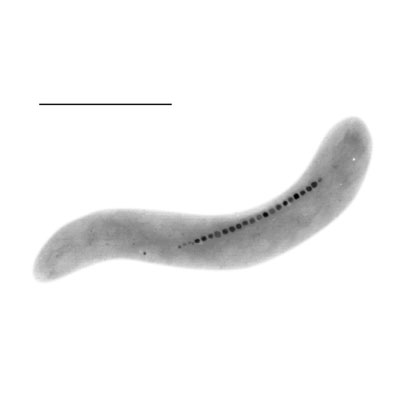Magnetospirillum magnetotacticum
Classification
Bacteria (Kingdom); Proteobacteria (Phylum); Alphaproteobacteria (Class); Rhodospirillales (Order); Rhodospirillaceae (Class); Magnetospirillum (Family); Magnetospirillum (Genus)
Species
Magnetospirillum magnetotacticum (Synonym: Aquaspirillum magnetotacticum)
Description and Significance
Genome Structure
Magnetospirillum Magnetotacticum has a circular genome, consisting of a total of 9,211,536 base pairs, 66.43% of which are G+C pairs. Protein coding genes comprise 99.08% of the genome, the rest coding for rRNA genes. there are no pseudo genes present in the genome. Though no extrachromosomal structures are found when analyzing undigested DNA, one study found possibile evidence of circular plasmid of 40,000 base pairs that contains 16s rRNA, bra and por genes, made linear and thus detectable by enzyme digestion. An interesting feature of the chromosome is the clustering of genes that contribute this microbes magnetotaxicity. The genes bfr (coding for the iron the iron storage protien bacterioferritin) and magA (coding for the magnetosomal mambrane that surrounds magnetite crystals), are located maximally in the same 17% of the genome, though further studies expect to find that they are indeed much closer together. Also interesting is the overlapping of two bfr genes. Very few magnetotactic bacteria code for two bfr genes, and the few that do, have no overlap. The reason for the overlap is possibly to keep the two genes in proximity, or could play a role in the regulation of the amounts of bacterioferritin protein produced. Magnetospirillum Magnetotacticum was the first magnetotactic bacteria to be phylogenetically analyzed using 16s rRNA genes. This is because it was one of the first magnetotactic bacteria to be isolated in pure culture. Origional analysis placed the bacteria in the aquaspirillum genus, however further studies have placed it in a new genus of magnetospirillum. This study resulted in the folowing evolutionary distance tree.
Cell Structure, Metabolism and Life Cycle
Ecology and Pathogenesis
References
1)NCBI: Magnetospirillum magnetotacticum[1]
Author
Page authored by Susan Jarosz and Megan Hull, students of Prof.Jay Lennon at Michigan State University.

